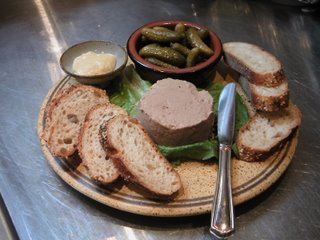Chicken Livers with a Velvet Touch

Julia Child wrote that the memory of a good French pate can haunt you for years. I don't know how universal this statement remains, but I do remember my first: It was on Waikiki in '77. (I also had my first twice-baked potato here and saw Bocuse's Truffle Soup.) I had no idea what it was, except it was called foie gras and served in a little brown pottery dish unlike the rest of the china. It was a while before I figured out exactly what that was, and how exactly this differed from Spam and an Underwood canned spread. The animal lover in me felt sorry for the ducks and geese, but at those prices, I realized that it was not a moral dilemma I would often face.
Over the years, I resisted the mousses and pates made from chicken livers. And you know what? I admit that it was part snobbery. Chicken livers just seemed so, so..."ghetto" or white trash or hicksville. But lately, I have been enjoying liver in general more often, and a few weeks ago I took the plunge at Seattle's current food rave Cremant, where I ordered the Gateaux de Foies de Volaille (Chicken Liver Mousse). Like the rillettes at Le Pichet and the cured meats at Salumi, the mousse transported me across the Arctic Circle to Europe (from Seattle, BA doesn't fly over the Atlantic), and I realized that a little bit of Paris was to be found a few blocks away.
When the New York Times published its article on Salumi's culatello, and the resulting press wiped out the supply until August, I had to find a new appetizer for my pre-opera dinner party. There was no doubt in mind what it would be, so I reached for my Balthazar Cookbook, which I have come to love for its recipe brevity, economy of procedure, photographs, and downright tasty food. Also pulled from the shelf were Mastering the Art of French Cooking, Volume One, Silver Palette, Ruhlman's Charcuterie, and La Bonne Cuisine de Madame E.Saint-Ange, the last being the most amazing cookbook I have read all year, and oddly enough, the polar opposite of the Balthazar Cookbook.
This was an incredibly easy and inexpensive (really cheap!) dish. the texture is as smooth as velvet, and as light as air. There is the earthy taste of liver, the warmth of spices, the richness of butter, and a green freshness from the thyme. It makes a great appetizer to serve during cocktails, or before dinner with Champagne or wine. Try different brandys such as Calvados (apple), Armagnac (prunes) as well as eau de vies (e.g., Poire William) for variations. Serve with either a baguette sliced and toasted (preferred), freshly sliced, or crackers. Cremant serves its Gateaux de Foies de Volaille in a lidded crock with a wire fastener. For an all too brief moment, you imagine that the proprietor himself has smuggled it from his grandmother's Perigold farm for your dining pleasure.
Before I filled the ramekins, I showed Dale the rich frothy brown mixture and remarked how an evil mother might fool her children into thinking she was allowing them to lick the bowl after making chocolate pudding.
Chicken Liver Mousse Mousse de Foies de Volaille or Gateaux de Foies de Volaille
Adapted from Mastering the Art of French Cooking and the Balthazar Cookbook
Serves 8 as a shared hors' doeuvre
1/4 pound melted, unsalted butter + 2 tablespoons softened unsalted butter
1 shallot
1/2 pound chicken livers, greenish or black spots removed
1 egg
1 tsp salt
Pinch of fresh thyme, freshly ground
1/4 tsp quatre epices (equal amounts of cinnamon, nutmeg, cloves and allspice ground in mortar and pestle)
1/8 tsp ground white pepper
1 tablespoon of Calvados (Cognac, Armagnac, or brandy are fine)
Preheat the oven to 300 F.
Rub 2 tablespoons of softened butter in three 4 ounce ramekins.
In a medium sized sauce pan over low heat, melt 4 tablespoons butter. Add shallots, and let simmer until soft, but not browned. Remove from heat and place in a medium non-reactive bowl. Add the chicken livers, egg, salt, thyme, and brandy. Process with an immersion blender, until smooth. Add the remaining melted butter, and continue blending until combined. (This can also be done in a blender.) Strain the mixture through a fine-meshed sieve, using the back of a spoon to push the mixture through. Discard the tablespoon or two of roughage remaining in the sieve. To the strained mixture, add the quatre epices powder and pepper, and blend until combined and evenly distributed. Take a tablespoon or two and drop it into an extra ramekin, and microwave it a minute as a taste test. Adjust seasonings as needed.
Divide the mixture between the three ramekins, and place these into a 9" square baking dish. Carefully fill the baking dish to half the height of the ramekins with warm water, and place into the preheated oven. Bake these for 30 minutes: the mousse should be firm to the touch, and an instant thermometer should read 165F. Let the ramekins cool before refrigerating in a sealed container.
To serve: Dip a knife in hot water, dry it, and run it along the inside edge of each ramekin. Cover with a plate, invert, and shake. It should pop free onto the plate. (If not, shake harder, or carefully place in hot water a moment to warm the ramekin bottom.) Gently cup the mousse in your hand, invert, and transfer to a plate with a leaf of romaine or frisee. Add the remaining mousses or serve them on separate plates. Serve chilled with cornichons, French mustard, and toast or bread.


0 Comments:
Post a Comment
<< Home